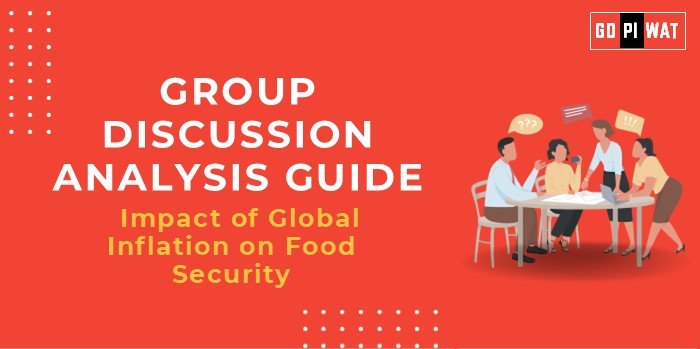📋 Group Discussion (GD) Analysis Guide
🌾 Impact of Global Inflation on Food Security
🌐 Introduction
Context: Rising inflation worldwide has intensified challenges related to food security, particularly in developing nations where basic staples dominate household expenditures.
Background: With inflation affecting agricultural production costs and supply chains, global food prices have surged, disproportionately impacting vulnerable populations.
📊 Quick Facts & Key Statistics
- Global Hunger Increase: Nearly 282 million people across 59 countries faced acute food insecurity in 2023, a rise of 24 million compared to 2022.
- Food Price Volatility: In 2020, low-income countries experienced a 1.1 percentage point inflation increase primarily driven by food price hikes.
- Agricultural Input Costs: Increased prices for fertilizers and fuel have raised production costs, contributing to higher food prices globally.
- Global Poverty Impact: Rising food prices force vulnerable populations to spend more on essentials, worsening poverty and limiting access to healthcare and education.
- Cereal Dependency: Heavy reliance on cereal imports makes countries highly susceptible to price volatility, exacerbating food insecurity risks.
🏢 Stakeholders and Their Roles
- Governments: Implementing subsidies, price controls, and import/export regulations to stabilize food markets.
- International Organizations: Coordinating global food aid (WFP, FAO) and advocating for sustainable agricultural practices.
- Private Sector: Innovating in cost-efficient farming and supply chain logistics.
- Farmers and Local Producers: Adapting to rising costs and contributing to local food security.
🌟 Achievements and Challenges
🎯 Achievements
- Resilience Measures: Nations like India and China have used strategic grain reserves to buffer against price spikes.
- International Aid: WFP assisted 110 million people globally in 2023.
- Technological Advancements: Use of AI to optimize agricultural yield in developed economies.
⚠️ Challenges
- Supply Chain Disruptions: Conflicts, like the Ukraine crisis, destabilize global cereal markets.
- Economic Strain: High inflation reduces purchasing power, disproportionately affecting low-income households.
- Climate Challenges: Extreme weather events compound food production challenges.
✨ Effective Discussion Approaches
- Opening Techniques:
- “In 2023, global food insecurity impacted over 282 million people—how can inflation be managed to reduce this trend?”
- “The rising cost of agricultural inputs like fertilizer and fuel presents critical challenges to global food security.”
- Counter-Argument Handling:
- Emphasize solutions such as technological innovations, subsidies, and trade agreements.
- Advocate for increased global cooperation to reduce cereal dependency.
🔍 Strategic Analysis of Strengths & Weaknesses
- Strengths: Resilience measures, improved awareness of global hunger issues, technological innovation.
- Weaknesses: Limited resources in low-income nations, climate impact on agriculture.
- Opportunities: Global partnerships, investment in alternative farming methods.
- Threats: Persistent geopolitical conflicts, increasing production costs.
📖 Structured Arguments for Discussion
- Supporting Stance: “Global inflation significantly exacerbates food insecurity, especially in import-dependent nations.”
- Opposing Stance: “Localized agricultural innovations and subsidy programs can mitigate the effects of inflation on food security.”
- Balanced Perspective: “While inflation poses a severe challenge, collaborative global strategies offer viable pathways for mitigation.”
📚 Connecting with B-School Applications
- Real-World Applications: Understanding inflation’s impact prepares students for roles in policy design, global trade, and supply chain management.
- Sample Interview Questions:
- “How can technological advancements address rising food insecurity?”
- “What are the economic trade-offs in subsidizing food production?”
- Insights: Focus on policy impacts and solutions during internships and case studies.


